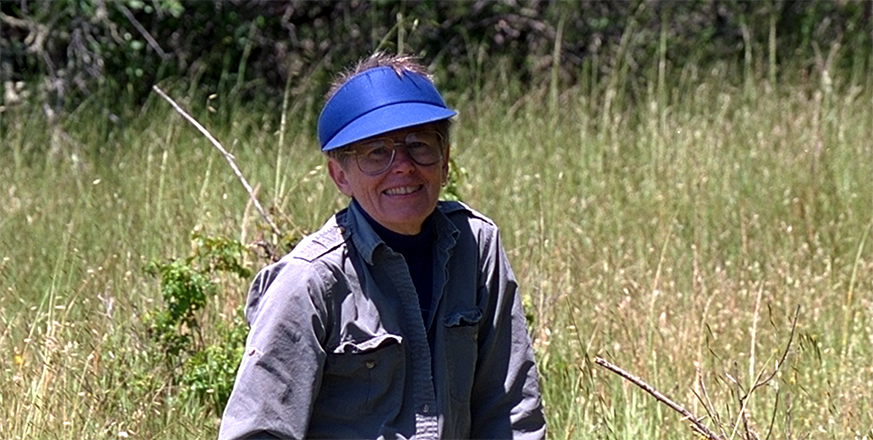Irene Brown - JRBP researcher, instructor, docent, and friend has passed away

Irene Brown—longtime Jasper Ridge researcher, instructor, docent, and friend—passed away on November 14; she was 87. Irene touched the lives of all of us in the Jasper Ridge community and inspired generations of colleagues and students with her scientific knowledge, scrupulous writing and editing, quick wit, warm heart and joy in spending time outdoors. Every one of us who knew Irene can recount organisms she identified for us, mysteries she explained, homegrown apples and figs she shared, or life lessons she imparted; most of us can recount all four. She did all of those things with a chuckle and a twinkle in her eyes. We knew she was sharing the things she loved, and we were inspired to love them, too.
Irene was a profoundly rigorous scientist. For decades, she studied the chalcedon checkerspot butterfly at Jasper Ridge. It was the subject of her 1971 doctoral dissertation and the subject of scientific publications coauthored by Irene, her doctoral adviser Paul Ehrlich, and other colleagues. Irene monitored the chalcedon checkerspot at Jasper Ridge for more than 40 flight seasons. One of her main discoveries was that the start of the flight season can vary by as much as 8 weeks, depending on conditions—a conclusion that required a deep dedication to longterm observation and consistency. At the outset of her research, Irene routinely visited 34 sites across Jasper Ridge, including several deemed totally inaccessible by other researchers. Irene was famous for her ability to penetrate impenetrable chaparral. Even in her later years she continued to monitor 7 to 9 key sites.
Unlike the Bay checkerspot butterfly, which disappeared from Jasper Ridge in 1998, the chalcedon checkerspot remains a common butterfly in the chaparral and woodland of Jasper Ridge. The difference in their fates is consistent with results from Irene’s 1980 paper (along with Paul and 4 other authors) on the effect of the 1975-77 California drought on the populations of these two sister species of butterflies across California. Their widely cited publication reported that during the extreme drought years, several populations of the Bay checkerspot went extinct, whereas none of the chalcedon checkerspot populations did. Irene and colleagues pointed to the role of larval food plant, upending their own predictions about the relationship between severe drought and density-dependent population regulation.
For many years, Irene was a regular instructor in JRBP’s flagship course, BIO 105, where she taught the core unit on ecology. An inspirational instructor, she used a variety of field experiences to train students to observe carefully, ask questions, and then question her answers. She was a voracious reader of technical journals and popular science and was always well informed on scientific debates; in particular, her knowledge of the literature on genetically modified organisms was especially broad and deep. She was also a one-person lending library, and her books frequently migrated among the Jasper Ridge staff and affiliates.
The bedrock of Irene’s life and work was Bob, her husband of 64 years. Their marriage was a remarkable partnership. Together they ran Benchmark Publications, writing, editing, and managing Narrow Gauge & Short Line Gazette, a magazine of international circulation considered the best in its subject. Visiting their home—as many people did during open house tours to see their famous model railroad—one could get a glimpse of how Bob and Irene were soulmates who supported each other’s attention to detail and expertise in two very dissimilar passions.
Irene conveyed her values openly and lived by those values—she valued the richness of nature over material wealth, scientific evidence over dogma, questions over answers, and friendship over followers. She was trusted, admired, and loved by the Jasper Ridge community, and will be deeply missed.
A celebration of Irene’s life will take place in the spring; details to follow.



